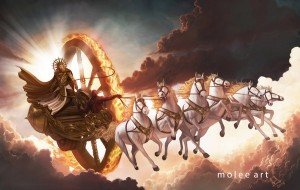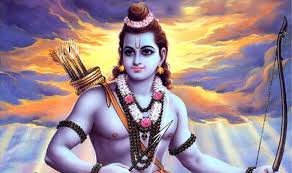The Aditya hridaya stotra is a poem/hymn to the Sun in the final confrontation chapter of the epic Ramayana written millennia ago by (according to the legend) a marauder turned sage Valmiki. The sequence itself is a reminder that even the weariest and discouraged moments of our lives can be supercharged with a little help from mother nature. I can suggest a number of mantras and sutras for meditation. It is only a matter of engaging your mind and intellect into observing something so one can delve into inner reserves of peacefulness. And it is not religion exclusive.

The Muslims have had several such experiences while in Azan, Dua or during the months of Ramzan. Christians have observed miracles while chanting the rosary. Jewish, Sikh, Jain and Buddhists have had similar occurrence. The stotra attracted my attention a while after it was suggested to me. It was in the language of Sanskrit, deciphering this language is like a constant mathematical puzzle, I have some skill with it which keeps inspiring me to hone my mind. But as I held on to my daily routine of chanting the whole thing thrice, with breaks for drinking water (as described in the stotra itself) there were some things that caught my attention and amazed me.
Now don’t get me wrong, there are other great treasures in all religions, communities, and traditions, it was just the one I found. I will look for more, however, for now, it gave me what I needed. Here’s what I learned:
Animation and divinity
Quantum physics teaches us that every nook and corner of the universe is energy, and energy by it’s very nature is a form that can be easily a strong presence of God as its many characteristics described in every scientific theory is identical to the ones depicted in theology and even mythology. Elements like the Sun, the moon, wind, earth, fire, thunder come alive as living beings while we thank and worship them. It is a simple matter of a whole heart. When we act in animalistic urges even people look like things, when we act with love and compassion, every nook and corner of the world comes alive.

Similar beliefs are visible in Japan where there are often signs that say “do not hurt the grass,” or people say “pick up your shoes, they’ll think that you don’t love them anymore.” A person who lives such a life is hard to put down. They can never stay alone, rarely suffer depression and their lives are dripping with orderly joy and positivity. A childish joy stems from such innocent faith.
Layers upon layers
People note that complex ancient languages often attract attention and stimulate the mind, it’s not because of their complexity, but often metaphors, symbolism and latent meanings. Often engineers and scientists go through ancient texts like the Vaimanika Shastra (aerodynamics and flight sciences by sage Bharadwaj), Bhrigu Sanhita (astrological sciences by sage Bhrigu) and end up skeptical and confused. It is hard to even understand things as such clearly and elitist secrecy doesn’t help.

What most people don’t realise is that science itself is moving at a ponderously slow state because of its nature to examine and test everything before believing it. The sciences themselves were documented by established and eternally famed seers of the ancient times with astoundingly limited resources. There isn’t going to be any progress unless belief comes before testing. It is why history and legends speak in parables and metaphors, one needs to have faith to be wiser not the other way round.Expectation breeds faith
There is a reason sage Agastya waits for the right time to divulge the secret to the exiled prince. People, even the God-king himself was given the help when he needed it most, and since he was already a Suryavanshi (heir to a family of Sun worshipers) it was easier and favorable for him to put utmost faith in it. Faith itself is a power beyond human understanding. Law of attraction and new thought arguments aside, Faith in oneself makes lives easier, sparks Imagination, gives ideas and energy. Moving mountains aside, we literally built observatories and eyes in the sky (satellites). Without it, you might even find it hard to stop stammering on a public stage or even have a reason to get out of bed.

But a solution or a remedy in prosperity or celebration almost always loses value. There would be no point in discussing ecology and naturalism in the times of industrial revolution. And why would anyone listen to you if you ask them to eat healthy while they party. Even the best of intentions and the greatest of help should be given when needed or asked for. The most wonderful of gifts loses its value when we have it in excess for us to take granted. Even the most harmful of things can have a high market price because they are rare. Timing is a skill.Rediscovered discovery
It amazed me when I went through some of the paragraphs of the famed hymn. Establishing that the Sun is constant, has seven Horses (symbolism for seven rays of the visible spectrum), is responsible for wind, rains, clouds, visibility of various stars, Time, seasons, history, ancestral rites, even the heat in every living creatures blood (all food is but processed solar energy) and that the system itself has nine planets under it. The revelations were astounding. They knew so much before the advent of Copernicus or even the entire scientific culture. And they could fit it all beautifully in symbolism and poetry.

Similar discoveries were made in other religions. Muslims knew of human digestive capacity and requirements when they declared certain animals as (halaal) edible and some as (haraam) unacceptable. They knew about the presence of hemoglobin in our bodies. Christians knew of Psychology as they introduced confessions to the priest and their holy vow to keep secrets. Every culture, every religion, every ritual or belief had one thing at its core, to protect and prosper you. In a mad chase for making sense and gaining power, we eschewed our past completely, only to rediscover the great secrets at an incredibly slow pace. And often we reject progress and growth by blindly sticking to dogma. Neither is a good attitude. To see real growth, we must develop a spirit of inquiry tempered with enough faith and understanding. One must question all laws and rules and beliefs and understand that every such thing was there for a reason. To understand that reason is to grow wiser, perhaps that was the reason for all the playful secrecy, to begin with.Praise is good
You might often hear famous and great people on television or in person being praised and reflexively saying, “You’re too kind.” Humility is a great virtue. It keeps us in touch with reality as it is. But the words here are honest in more ways than you know. Praising someone is acknowledging their good side, giving credibility to their honest effort. People have had a habit of crucifying all things bad and taking all things good in a stride. It’s actually the reverse of what should be done. Animal trainers in a circus could teach you, punishment for an act to any animal only encourages them to use it as a weapon to irk their trainers, praise or reward for something good makes them repeat it.

If you give a reaction, positive or negative to any action you only give it a stimulus to react to, attach an emotion with it which someone might grow used to feel. Besides the fact of human psychology, any ardent new thought follower could tell you that acknowledging the good can only increase its goodness to you. Whenever you praise God, you might actually be invoking some of the beautiful qualities in yourself. Remember what Paul said to the Philippians;Finally, brethren, whatever things are true, whatever things are noble, whatever things are just, whatever things are pure, whatever things are lovely, whatever things are of good report, if there is any virtue and if there is anything praiseworthy—meditate on these things. (Philippians 4:8 )
Gratitude attracts prosperity
Raam praises and thanks the Sun by his many names and characteristics, to his benefits and his presence in Nature itself. He praises the sun as a Super charismatic, peerless overseer, the actual practitioner of the three preliminary Vedas (oldest scriptures in recorded history), in fact, he calls him a holy sacrifice, sacrificer and the fruits of it all in one. Gratefulness to this extent cannot be imitated or feigned, it is a feeling transcending words, and yet only poetry could bring out all that he felt. It is an exhausted and discouraged warrior that needs energy and a zest to fight on. And he gets it, only because he was grateful to all that the universe has already had centuries before his time.

An exiled David in The Bible makes similar praises while dwelling in caves, they are called psalms. So does prophet Maula Ali’s mother while she was pregnant and running from armed assailants. Mahayana Buddhism makes similar praises to personifications of all positive human emotions like Avalokiteshvara (compassion) and Vajrasattva (faith). What happened next is the stuff of legends. Gratefulness is a gift in itself, often more powerful than a prayer and more genuine than a hymn. It reminds us that rituals or prayers or mantras or traditions mean anything only with our feelings that we attach to them. God, or the universe or our higher self already knows, they just need to feel it with our hearts.To each Their own
While I concluded my points on what I understood by my daily practice of the stotra, a friend came in, read the whole thing a few times and then raised a few more questions, put a few more points and humbled my recently inflated intellectual ego. Points like increased body heat in my own system as I chanted the mantra, the specific vibration of each phrase and word and their effect on my body, the need to regularly drink water between intervals among a few. Humility is endless, we’re never too wise to make a mistake. As I had my own understanding of the stotra, another mind understood the whole thing in another way. Same words, same poetry but different interpretations and equal truth to all. They are all unprovable yet plausibly visible realities. I would even call them theories if I wasn’t so amazed myself, but the point remains. No one person, no one viewpoint, no one perspective is enough to ascertain the truth. One must accept all aspects, no matter where they come from. It makes it easier for different castes and communities to live together. It makes it easier for religions to coexist. It makes it so much easier for humanity to grow as one.

Perhaps this is what the Aditya Hridaya (Sun’s heart) was made to teach us, to nurture the earth without it owing you anything, to see all the good and bad ways people live and light up their lives. To have warmth and light for every creature and thing you see and be angry enough to be noticed when you see the earth being treated unfairly (I’m talking about global warming and pollution if you didn’t catch on). To be all accepting and ceaselessly warm and nurturing is perhaps the ultimate lesson from the heart of the Sun.











Leave a Reply